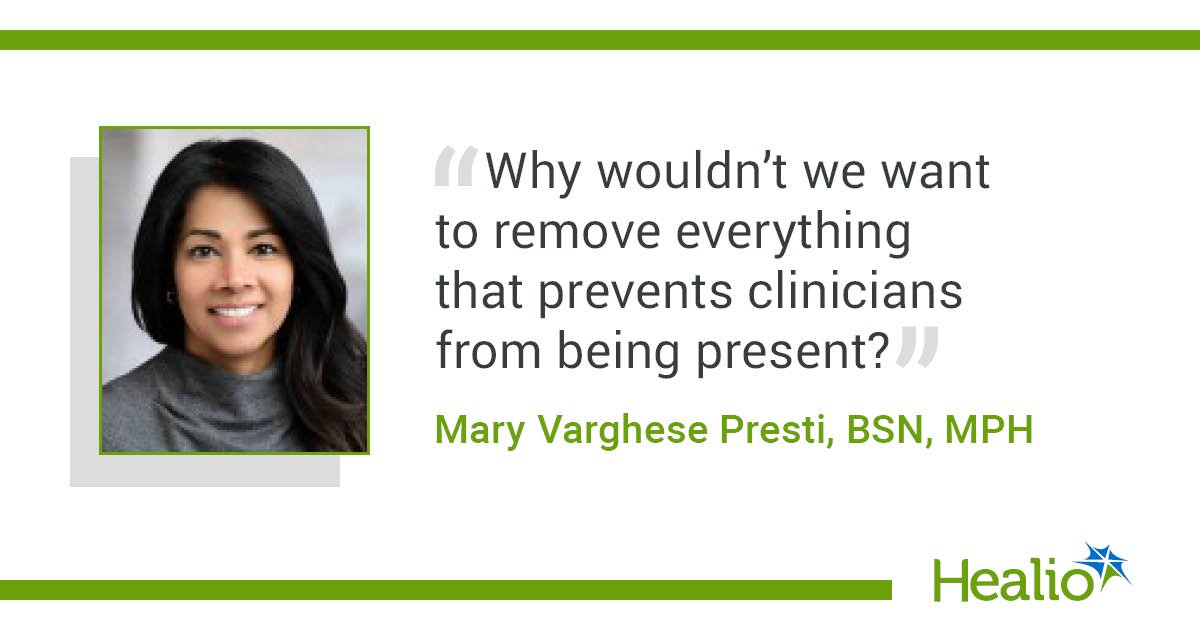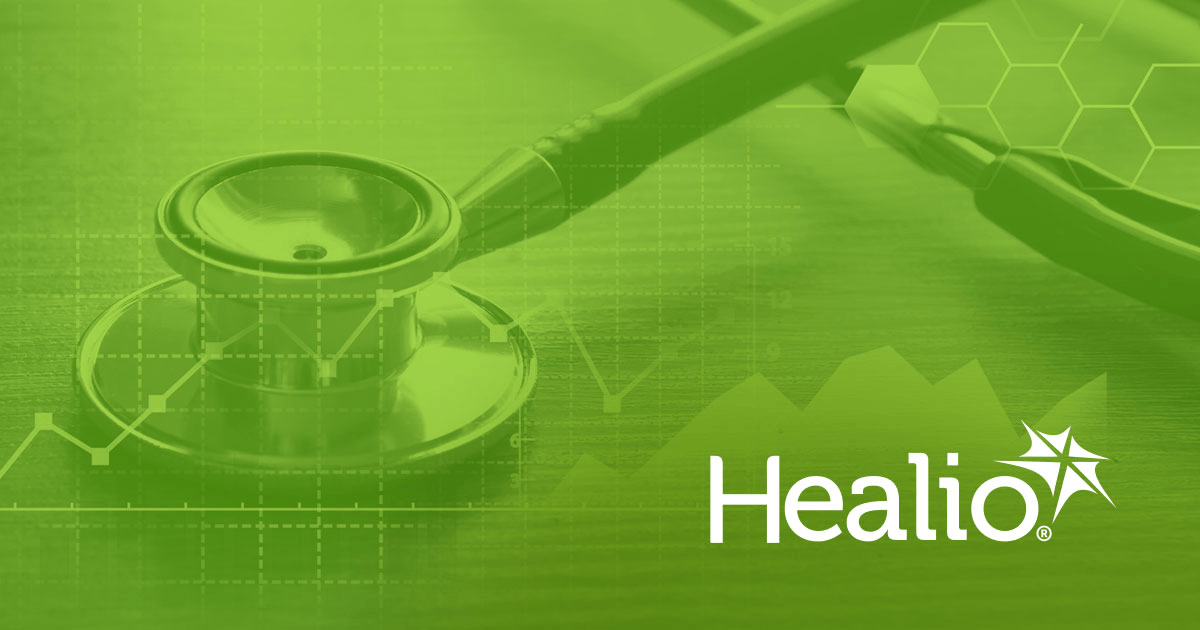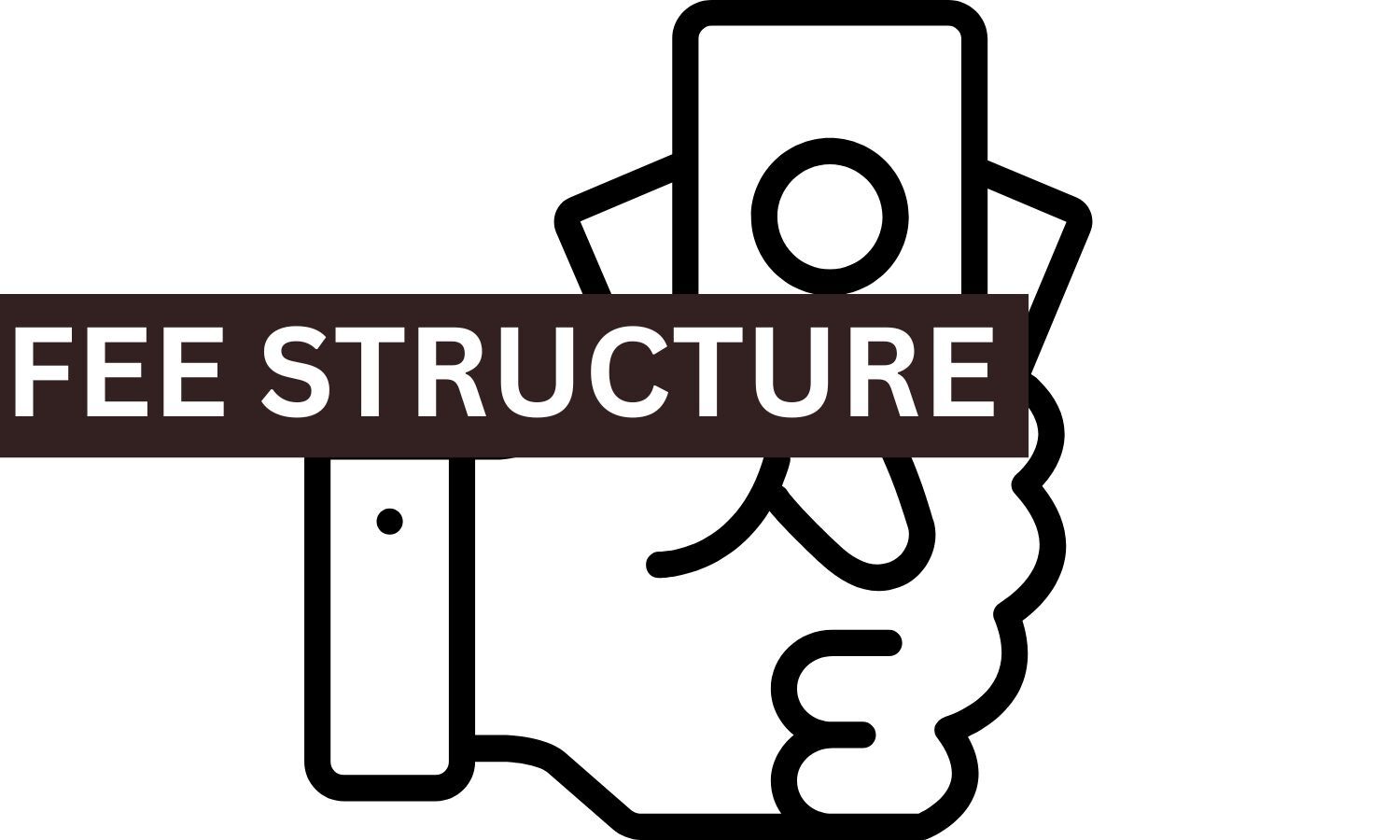November 11, 2025
10 min read
Key takeaways:
- AI automates routine tasks so clinicians can focus on patients, not paperwork.
- AI also can increase revenue while reducing burnout.
- Tools already are available, and those who do not use them will be left behind.
In 1891, Luke Fildes painted “The Doctor,” illustrating a physician leaning intently over a sick child, fully present, hands ready to heal.
In 2012, a drawing by a child aged 7 years, published in JAMA, showed her own doctor visit, with the physician’s back turned, typing at a computer.

This is modern medicine’s tragedy captured in two images. And it is why Mary Varghese PrestiBSN, MPH, refuses to talk about AI as technology.
“Technology was never meant to be the main point,” Presti told me during our exclusive interview at HLTH 2025, the world’s largest health innovation conference drawing 12,000 health care leaders to Las Vegas.
The former pediatric nurse who once folded patient notes into quarters and tucked them in her scrubs pocket now commands Microsoft’s entire health care AI strategy as corporate vice president of health and life sciences.
“Tech actually goes into the background and allows humanity to come to the foreground,” she said.
Fresh from delivering a keynote to 5,000 attendees where she opened not with demos but with a 200-year-old stethoscope, Presti shared insights that go beyond Microsoft’s platform.
“The stethoscope endured because it works,” she explained from the stage. “It augments human capability without replacing it.”
A broad ecosystem, from electronic health record vendors to clinical AI startups, is converging on the same aim: make technology invisible so care becomes human again.
But here’s what many leaders, even at the biggest platforms, haven’t fully connected. The transformation is happening faster than anyone thinks, and it is being driven not by technology but by economics.
Presti is rare. She was a frontline nurse who now architects the systems. Her mother was recruited from India during the 1970s nursing shortage, “part of a wave that crossed oceans to fill workforce gaps,” as Presti described it. Presti followed, working 12-hour shifts at Johns Hopkins caring for critically ill children.
“I’d draw columns and rows on paper: a column for every hour, a row for every patient,” she recalled, demonstrating with her hands how she would fold the paper. “Folded into quarters, tucked in my pocket. If I lost that piece of paper during those 12 hours, I was out of luck.”
Today’s nurses spend at least 25% of their shifts charting on workstations on wheels, ironically called WOWs.
“Most nurses I speak to say it’s way, way higher,” Presti noted. “We over-rotate toward the highest tech, not necessarily the best tech for people working in health care systems.”
Presti also said that physicians spend their “pajama time” completing charts.
“We’ve all experienced talking to the back of a physician or having a computer between us,” she said.
This October, Microsoft announced ambient AI built specifically for nursing workflows, not recycled physician tools.
“Physicians document very differently,” Presti emphasized. “What we built here for nurses is not a rinse and repeat of that.”
The economic earthquake nobody sees coming
When I explained to Presti that CMS’s new Advanced Primary Care Management (APCM) codes eliminated time-tracking requirements, she stopped mid-sentence.
“So, you’re saying that CMS is removing the fee schedule based on time and levels?” she asked.
After I confirmed it, she processed the implications.
”It’s kind of like Venmo, right? We couldn’t have envisioned it, but it creates new economies, decreases friction, creates new markets,” she said, before adding something crucial. “Anytime you bring new technology, anytime you change incentives, you’re incentivizing something different.”
Here is the part nobody explains clearly.
In the old reality, a primary care physician had 20 appointment slots per day. They saw a thousand patients who needed three or four visits yearly. The math did not work. They were drowning. Annual revenue was approximately $300,000. Burnout was guaranteed.
In the new reality, the same physician has the same 20 daily slots. But with AI-enabled care management handling routine questions, medication refills and lab reviews between visits, each patient only needs one or two visits per year instead of three or four. Suddenly, that physician can manage 2,000 patients with the same appointment capacity.
The key insight? Same visit capacity. Half the visits needed per patient. Double the panel size.
Here’s where it gets interesting. The traditional visit revenue of $300/patient/year stays the same. But what’s new is that APCM adds $50 to $110/month (600-1,320/year) per patient. Total panel revenue is now $1.8 million to $3.2 million annually.
The work happens through an AI-amplified care team.
“Agents handle the rote, structured things that don’t require you as a clinician,” Presti explained. “Why not have an agent do it so you can actually spend all your time doing things that only you can do?”
But here’s what nobody talks about. This isn’t just for primary care.
While APCM and proposed Generalized Partial Credit Model (GPCM) codes (coming in 2026 as part of the new CMS fee schedule) are specific to primary care, every specialty has parallel opportunities.
In psychiatry, we use Chronic Care Management codes to build similar continuous care models. Cardiology, nephrology, endocrinology — each has its chronic care codes. The beauty of modern platforms is they keep this code complexity beneath the waterline. Clinicians just practice while the platform orchestrates which codes apply.
The pendulum is swinging decisively toward continuous engagement and value-based care. The incentives are dramatic and powerful. Those who don’t learn to practice in this new world won’t just miss opportunities. They will face competitive disadvantage.
With primary care in desperately short supply, physicians with proper infrastructure can now serve their entire community excellently, not just fragments.
Patients feel it immediately with faster answers, fewer duplicate tests and earlier interventions. It is an equity play too, with multilingual, omni-channel outreach ensuring the system checks on patients who rarely raise their hands.
Health care AI’s three-act revolution
At HLTH, Presti mapped the trajectory with striking clarity, using a visual framework of ambient, generative and agentic AI. When she said it, you could feel the room lean in.
In act one of health care AI’s three-act revolution, there is now an ambient returns connection.
“Dragon Medical is already used by over 500,000 physicians,” Presti noted.
With ambient capabilities, documentation happens invisibly. JAMA studies show a 22% reduction in documentation time. Burnout drops from 50.6% to 29.4% after 42 days.
“Our clinician clients using ambient scribing don’t want to give it up,” Presti said with conviction. “They’re like, ‘Okay, this is the only way I want to practice.’”
Presti said that one physician told her about helping an elderly patient decide to enter hospice care.
“‘What a mercy it was that I was actually able to have the entire visit while holding both hands of my patient,’” Presti said the physician told her.
In act two, which is now emerging, agents handle the routine.
Consider Stanford Medicine. Presti shared its reality with evident excitement.
“Stanford Medicine sees 4,000 tumor board patients a year,” she said. “The new health care agent orchestrator has the power to streamline this existing workflow by reducing fragmentation, saving time by avoiding copy-pasting, and enables surfacing new insights.”
AI agents now prepare tumor boards in minutes instead of hours.
“It might diagnose better, and it might run through a ton of stuff and find patterns that I might not have seen,” she explained. “But as a clinician, I look at that and I verify it. It’s not that different from a med student that has to do the grunt work and bring it to an attending. You still have to look at that and agree or disagree and sign off on it.”
In act three, there will be a hybrid workforce.
“Today, nurses can’t really delegate. Who would they delegate to?” Presti asked rhetorically. “Tomorrow, will agents handle the predictable, structured tasks in the background.”
Presti envisions 2027 as the era when “nurses become conductors, agents become the orchestra.” But with APCM live now and GPCM likely for 2026, many practices are already there.
“How comfortable and skilled we get is going to determine how fast and how far we go,” she observed. “The models are ready. We are the limiting factor, not the AI models.”
A day in the new life
“By 2027,” Presti predicted, “the nurse is engaging with patients and their eyes are free and their hands are free. They’re just talking.”
Information gets pulled effortlessly, with hospital policies, clinical guidelines, medical content, all there when needed.
“The things in their shift that don’t require a nurse to do are being done for them by various agents,” Presti said. “You had a cognitive load, you had a physical load, but you also had an emotional load. You didn’t go to work that day to never actually get the time to go in and see that person. If we can remove all three of those, I think that’s possible.”
This isn’t fantasy. It’s Tuesday for practices already implementing these models.
Microsoft is additionally transforming Dragon into a platform where developers build apps.
“Think about it like your iPhone,” Presti said. “If you want to listen to Spotify, you don’t have to go somewhere else. You just do it in your iPhone because that’s where you want it to be.”
Presti described the ecosystem.
“There are exciting new companies coming up with innovative use cases,” she said. “The barrier to entry for those companies, if you think about the enterprise sales cycle of going to a health system, there’s a time to market issue. This is how we as a partner help reduce that barrier to entry.”
KLAS shows adoption rising across vendors such as Abridge, Epic and Microsoft. The transformation is industry-wide, not single-vendor.
Risks exist, such as over-delegation, alert fatigue, audit gaps and privacy drift. But safeguards are built in.
“We have seven steps to how we think about responsible AI, and we do that by design,” Presti emphasized. “It’s not like we create our product and at the end we go through a checklist. Every step involved in the product is going through fairness, bias, accuracy – all of these different things.”
Provenance on agent actions and a clean audit trail also are critical.
The urgency she states plainly
“It took Netflix 10 years to get to 100 million users. It took ChatGPT 2 months,” Presti said. “It just blew the roof off everything.”
Health care moves differently, but the message is clear.
“Don’t be scared of AI,” Presti advised. “Get informed. Dabble with it. Get comfortable. You can do it in your personal life. You don’t have to do it in the work setting necessarily. But get started.”
Practices watching from the sidelines face competitive disadvantage within months, not years. Next month, when you’re drowning in 6-minute visits while your competitor down the street is managing 2,000 patients profitably with AI-enabled care management, remember this moment. Remember when you could have led instead of followed.
But when pressed about AI’s ultimate role, Presti’s response revealed her nurse’s heart.
“If I’m at my most vulnerable point in a hospital bed, I want a human person: the embrace, the connection. I don’t want to be embraced by AI.”
But she sees AI enabling that human connection.
“Why wouldn’t we want to remove everything that prevents clinicians from being present?” she asked. “The ritual of examining a patient also has transformation.”
Tomorrow morning, when you return to your practice, notice every moment technology steals from patient care. Your 6-minute visits. Your pajama time. Your patients waiting weeks for answers.
Now imagine what Presti described: “Eyes free, hands free, talking not typing. The 12-hour shift becomes 12 hours of actual patient care.”
The platforms are ready. Tech companies have built the foundation. The economics are compelling: $1.8 million to $3.2 million for managing 2,000 patients well versus $300,000 for managing a thousand poorly.
But the real driver is moral. We finally have the tools to serve entire communities, not just fragments.
These care management models have been refined over decades by innovators at Kaiser, Intermountain and Geisinger and in practices nationwide. Digital health companies are now encoding them, making proven approaches accessible to any clinician.
At Zenara Health, we’re focused on the orchestration intelligence: how AI decides which patient needs what, when. The platforms have the highways. Companies like ours are building the GPS that makes them useful.
“Technology was never meant to be the main point,” Presti reminded me. “The real intent? Tech actually goes into the background and allows humanity to come to the foreground. That’s where the true value will be.”
The child who drew her doctor with his back turned deserved better. Every patient deserves what Fildes painted. The difference now? Excellence is finally economically sustainable.
Presti’s nurse-to-architect lens is precisely the leadership medicine needs: human first, methodical, and ready for scale. Her insistence that technology must disappear so humanity can return isn’t just Microsoft’s position. It is the North Star the entire industry needs.
The infrastructure exists. The payment models align. The ecosystem awaits. But the window is finite. The transformation is inevitable. Lead it, or watch it happen around you.











